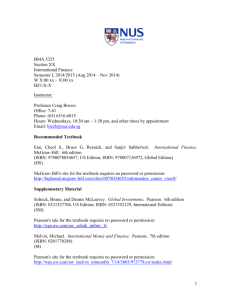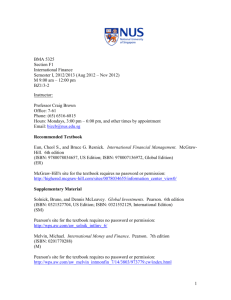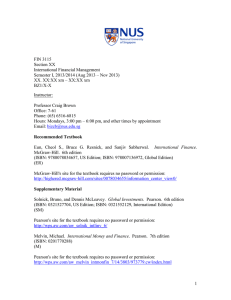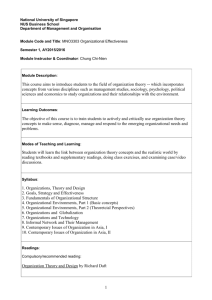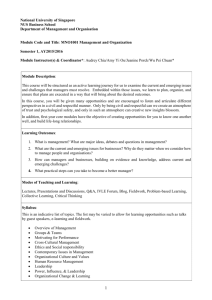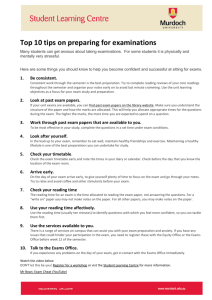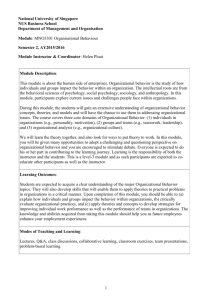1 FIN 3115 Section XX International Financial Management
advertisement
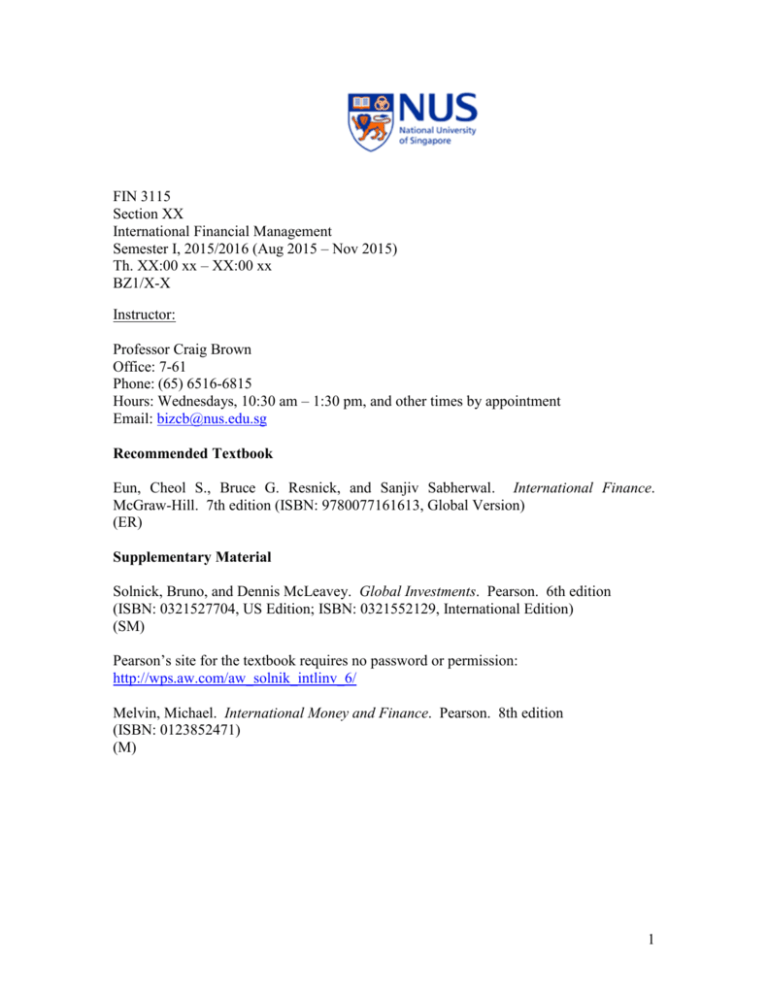
FIN 3115 Section XX International Financial Management Semester I, 2015/2016 (Aug 2015 – Nov 2015) Th. XX:00 xx – XX:00 xx BZ1/X-X Instructor: Professor Craig Brown Office: 7-61 Phone: (65) 6516-6815 Hours: Wednesdays, 10:30 am – 1:30 pm, and other times by appointment Email: bizcb@nus.edu.sg Recommended Textbook Eun, Cheol S., Bruce G. Resnick, and Sanjiv Sabherwal. International Finance. McGraw-Hill. 7th edition (ISBN: 9780077161613, Global Version) (ER) Supplementary Material Solnick, Bruno, and Dennis McLeavey. Global Investments. Pearson. 6th edition (ISBN: 0321527704, US Edition; ISBN: 0321552129, International Edition) (SM) Pearson’s site for the textbook requires no password or permission: http://wps.aw.com/aw_solnik_intlinv_6/ Melvin, Michael. International Money and Finance. Pearson. 8th edition (ISBN: 0123852471) (M) 1 Course Description In this course, we will place our emphasis on the international financial system, international investments, and international financial management, particularly in Asia. This course is especially helpful for a student pursuing a career in international banking, global asset management, or international corporate finance. Our course begins with a thorough analysis of international business risks and the structure of the international monetary system. We will then cover the following topics: the foreign exchange market; exchange-rate determination; international investments; currency and rate risk management; international capital budgeting; international political risk and corporate governance in Asia; and international banking and liquid asset management. Course Objective We have one overarching objective in this course: to master the general framework of international finance; a framework that highlights the fundamentals. One of my duties as the “prof” is to lay the groundwork for you to be an active learner of international finance. I prefer to couch the concepts of the course in terms of your questions. Given the foundation, you should eventually develop your own questions about international finance. There is no doubt that you will develop a solid competence in the advanced concepts and techniques if you develop your own questions. Course Format Our course has four approaches to teaching in class: lecture, problem-solving, the case method, and the discussion of “real-world” events. You will benefit greatly from going over the associated readings and textbook chapters before class. The quality of your education in this course is primarily driven by the quality of your questions, and my answers to those questions. Each student is different. Your questions might be common but, more often than not, they are posed in unique ways. We will solve problems in this course, but you will not be rewarded for rote memorization. Given the time that you dedicate to this course, an efficient use of time would be for you develop your own questions about international finance. Furthermore, you are encouraged to read the Wall Street Journal, Financial Times, and The Economist to pose questions within the context of current events. 2 Learning Outcomes Students are expected to exhibit competence in the following subjects: international risk assessment, international investment decision-making, and international capital budgeting. Study Questions There are two exams in this course. In preparation for the exams, the students are encouraged to complete two sets of study questions: an Exam 1 set and an Exam 2 set. Students should submit their answers for each set prior to the review class for each exam. For example, students should submit their answers for the Exam 1 study questions at the start of Class 4. The study questions will not be marked. However, a student’s successful completion of the study questions will reflect well on the student for the class participation component of the overall course grade. The correct answers for the study questions will be presented during the associated review class. Exams There are two exams in this course. Each exam consists of three sections: true/false, multiple choice, and short answer. Exam 2 focuses on the topics that are not covered in Exam 1. For each exam, students are allowed to bring ONE (1) sheet (A4 size, doublesided) of notes and a calculator. Only NUS approved calculators are allowed. Be sure that you know how to use your calculator before you take the exams. Calculator user manuals are not allowed in the exams. Grading Your course grade is based on your overall performance in the class (exams, class participation, and the group project). The following percentage weights are used to form your overall course average: Item Class Participation Exam 1 Exam 2 Group Project Total Weight 10% 20% 30% 40% 100% 3 Groups and Projects In this course, there will be a major group case project that involves both a written report and an oral presentation. Students will be assigned to nine groups by the beginning of Class 4. Each group member is responsible for the entire project report, and will be expected to rate the other members of the group based on effort and competence. We will cover three group case projects during the semester. Out of the nine groups, there will be three primary groups for each case. Groups 1A, 1B, & 1C will take on the primary responsibility for Case 1; groups 2A, 2B, & 2C for Case 2; and groups 3A, 3B, & 3C for Case 3. Each primary group will submit a double-spaced, typewritten comprehensive report not exceeding 10 pages of text (the main body of the text excludes tables and appendices). The due date for the written report is listed in the right margin of the Class Schedule. Each primary group must distribute its written report copies to the critique (non-primary) groups by the due date for the comprehensive report. For each assigned primary group, the critique groups are required to submit a one-page critique of each report at the start of class on the first day of project presentations. The group assignments are as follows: Case Number 1 1 1 2 2 2 3 3 3 Presenting (Primary) Group 1A 1B 1C 2A 2B 2C 3A 3B 3C Critique (Non-Primary) Group 2A, 3A 2B, 3B 2C, 3C 1A, 3A 1B, 3B 1C, 3C 1A, 2A 1B, 2B 1C, 2C During each project presentation, the presenting group will be given 45 minutes to present analysis and insights. Comments will be solicited from the critique groups. All students are expected to actively participate in the project discussions. The project assignment along with guidelines will be made available on IVLE at least two weeks before the due date for the comprehensive report. Submission Policy ALL group reports and critiques should be submitted by the relevant due date. Late submissions will be penalized by at least 20 percent. 4 Academic Honesty and Plagiarism Academic integrity and honesty is essential for the pursuit and acquisition of knowledge. The University and School expect every student to uphold academic integrity & honesty at all times. Academic dishonesty is any misrepresentation with the intent to deceive, or failure to acknowledge the source, or falsification of information, or inaccuracy of statements, or cheating at examinations/tests, or inappropriate use of resources. Plagiarism is ‘the practice of taking someone else's work or ideas and passing them off as one's own' (The New Oxford Dictionary of English). The University and School will not condone plagiarism. Students should adopt this rule - You have the obligation to make clear to the assessor which is your own work, and which is the work of others. Otherwise, your assessor is entitled to assume that everything being presented for assessment is being presented as entirely your own work. This is a minimum standard. In case of any doubts, you should consult your instructor. Additional guidance is available at http:// www.nus.edu.sg/registrar/adminpolicy/acceptance.html#NUSCodeofStudentConduct Online Module on Plagiarism, http:// emodule.nus.edu.sg/ac/ 5 Class Schedule (Semester I, 2015/2016) Class Week Ch. in ER Topic 1 Aug. 10 1-3, 9, 11 Review Domestic Finance Multinational Finance and International Investments Collapse in Asia - 1997/98 Exchange Rate Policy at the MAS 2 Aug. 17 5, 12-13 The Foreign Exchange Market 3 Aug. 24 8, 10, 1214 Bonds, Interest Rates, and Swaps 4 Aug. 31 . E1 Sep. 7 1-3, 5, 9, 11-13 Exam 1 [Saturday, 3pm - 6pm] 5 Sep. 14 15-17, 21 International Capital Budgeting --- Sep. 21 --- Due Finish & Review Fall Recess 6 Class Schedule (Semester I, 2015/2016) Class Week Ch. in ER Topic International Banking, Money Markets, and Liquidity Management Corporate Inversions: Stanley Works and the Lure of Tax Havens Case Analysis Walt Disney Co.’s Yen Financing Financing the Mozal Project 6 Sep. 28 7,18-19 7 Oct. 5 . 8 Oct. 12 . Project Presentations: Day 1 9 Oct. 19 . Project Presentations: Day 2 10 Oct. 26 . Project Presentations: Day 3 11 Nov. 2 . E2 Nov. 9 7-8, 10, 12-13, 1519, 21 Due All Reports All Critiques Review & Topics in International Finance Exam 2 [Saturday, 3pm - 6pm] 7
